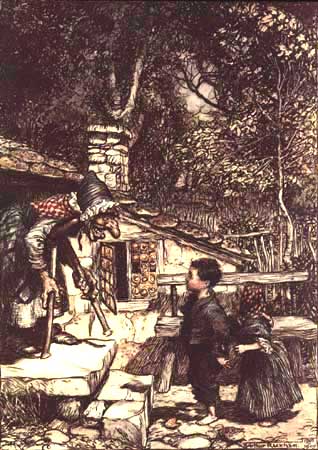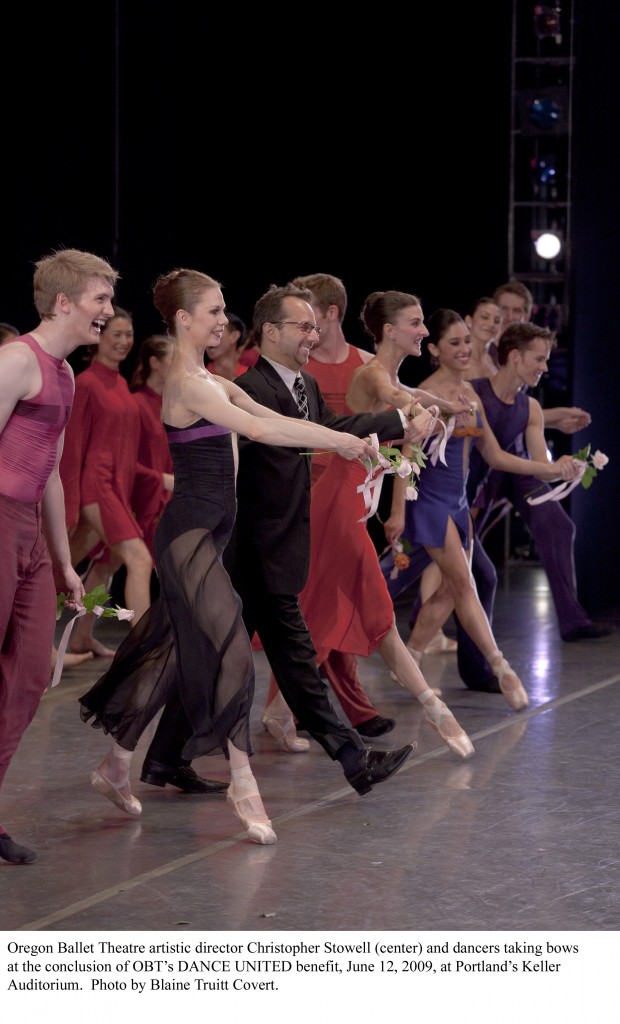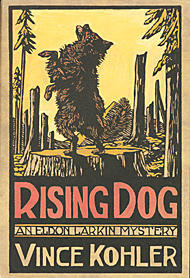Like so many great art forms, dance is a series of interlinked relationships and memories, a tradition that continually redefines and reinvents itself. It lives in the past, and the present, and the future, and its story is written in the memories and associations of open-hearted observers as well as the muscles of dancers and the patterns in choreographers’ minds.
Dance writer Martha Ullman West, one of our best observers, took in last Friday’s Dance United, and for her it was like biting into a madeleine: The reminiscences and connections just began to flow. Somehow, no matter how far-flung, they all looped back to Oregon Ballet Theatre, its history and successes, and this extraordinary event to keep the company alive and vital.
Here is the link to Martha’s review in The Oregonian of the performance. And here, below, is her more personal report on what it all meant:
———————————————————————-
 Really, it was a cross between a potlatch and an Obama rally, a gathering of the clans.
Really, it was a cross between a potlatch and an Obama rally, a gathering of the clans.
Dancers came from Texas, Utah, Massachusetts, Canada, Washington state, California, Chicago, Idaho, and that other geographical location, in New York called Downtown, here designated as Portland’s modern and contemporary dance community.
The gifts they brought were generous: their talent and their time. And they were welcomed to Keller Auditorium with the same enthusiasm as Obama’s supporters do and did, reaching into their wallets with many relatively small donations to keep Oregon Ballet Theatre alive. On Tuesday, OBT had in hand $720,000 of the $750,000 it needs to make up THIS season’s deficit.
I’ve been watching dance in Portland and elsewhere for more decades that I wish to reveal, and professionally since 1979, when I wrote an essay on postmodern dance in New York for Dance Magazine. In so many ways, this gala triggered some Proustian moments, also making me think of all the ways that dance and dancers are connected to each other.
Linda Austin’s thoroughly postmodern “anybody-can-dance, any-movement-on-stage-is-valid” Boris & Natasha Dancers (on catnip) took me back to New York’s SoHo and a performance created by Karole Armitage consisting of a group of dancers on their hands and knees, painting stripes on the floor, in humorless silence. They were not skilled at either painting or dancing, but it was the same democratic approach to the art form as Austin’s new dance, which featured such pillars of the Portland community as two Bragdons (Peter and David), Scott Bricker, James Harrison and Peter Ames Carlin galumphing across the stage, one of them wearing red sneakers that I wondered if he’d borrowed from White Bird’s Paul King. (Armitage, you may remember, also made work on OBT’s dancers on James Canfield’s watch.)
 The Joffrey Ballet’s Aaron Rogers, performing Val Caniparoli’s Aria, recalled for me the profound pleasure of watching Val work with Portland dancers, first at OBT’s precursor Ballet Oregon, and then at OBT. Caniparoli’s kindness and courtesy in the studio turned out to be extremely productive when the company performed his Street Songs and other work. Rogers looked like he was enjoying himself, flirting with that mask, and certainly seduced the audience in the process.
The Joffrey Ballet’s Aaron Rogers, performing Val Caniparoli’s Aria, recalled for me the profound pleasure of watching Val work with Portland dancers, first at OBT’s precursor Ballet Oregon, and then at OBT. Caniparoli’s kindness and courtesy in the studio turned out to be extremely productive when the company performed his Street Songs and other work. Rogers looked like he was enjoying himself, flirting with that mask, and certainly seduced the audience in the process.
And I thought about Mark Goldweber, ballet master at OBT under Canfield, then for some years at the Joffrey, and now at Ballet West. (He gave the only authentic performance in Robert Altman’s dance film The Company, in my view.) I wondered what Mark thinks about the way Adam Sklute, now Ballet West’s artistic director, staged this version of the White Swan pas de deux.
When I encountered this ballet’s real-life Prince Siegfried, Christopher Ruud, at OBT’s studios earlier in the week, I spoke with him about his father, who had helped Todd Bolender at Kansas City Ballet (Bolender is the subject of a book I’m working on). Ruud told me he had staged one of his father’s pieces on the company several years ago.
Continue reading Martha Ullman West on Dance United: a personal take
 The smashing success of last Friday’s
The smashing success of last Friday’s  Who would have thought? Google “smelly boys” and in the first dozen entries you will find adverts for scents and refrigerator magnets, videos of boys smelling their socks, and
Who would have thought? Google “smelly boys” and in the first dozen entries you will find adverts for scents and refrigerator magnets, videos of boys smelling their socks, and 
 As I realized I was having
As I realized I was having 
 But on Wednesday the large smelly boys were paroled from a nine-month sentence in the Portland public school system, and
But on Wednesday the large smelly boys were paroled from a nine-month sentence in the Portland public school system, and  dateline willow lake – Kum ‘N Go is gone, replaced (in name sign only) by Super X. In my South Dakota hometown the once “Ye Olde … Whatever†signs have been replaced by vintage-script “Whatever . . . Shoppe†ones. And I forget how delightful it is to name the surrounding towns: Letcher, Loomis, Woonsocket, Ree Heights, Yale, Carthage, Carpenter and Iroquois, and the still barely 300+ Willow Lake, where I spent most of my first fourteen years, and where today I visit my Aunts Gloria and Rose, my only remaining relatives of my parents’ generation, who live a block apart, or, almost across town from each other.
dateline willow lake – Kum ‘N Go is gone, replaced (in name sign only) by Super X. In my South Dakota hometown the once “Ye Olde … Whatever†signs have been replaced by vintage-script “Whatever . . . Shoppe†ones. And I forget how delightful it is to name the surrounding towns: Letcher, Loomis, Woonsocket, Ree Heights, Yale, Carthage, Carpenter and Iroquois, and the still barely 300+ Willow Lake, where I spent most of my first fourteen years, and where today I visit my Aunts Gloria and Rose, my only remaining relatives of my parents’ generation, who live a block apart, or, almost across town from each other. A website away, I find that POET, LLC has spent twenty years “defining the art of biorefining,†that is, the production of ethanol from corn. POET began as a family farm operation in Wanamingo, Minnesota, in 1983, turned commercial operation in Scotland, South Dakota in 1986, and now has some two dozen plants in seven states throughout the Midwest. How have I missed this?
A website away, I find that POET, LLC has spent twenty years “defining the art of biorefining,†that is, the production of ethanol from corn. POET began as a family farm operation in Wanamingo, Minnesota, in 1983, turned commercial operation in Scotland, South Dakota in 1986, and now has some two dozen plants in seven states throughout the Midwest. How have I missed this?  THE LATEST NEWS FROM OREGON BALLET THEATRE, which is struggling with a life-threatening deficit that has it feverishly trying to raise $750,000 by June 30 to keep from going out of business: The campaign hit the $524,000 mark by Wednesday. That morning OBT’s Erik Jones said 900 tickets were still available for Friday night’s gala benefit performance Dance United, which will bring star performers from across North America to raise money for OBT. Buy your tickets
THE LATEST NEWS FROM OREGON BALLET THEATRE, which is struggling with a life-threatening deficit that has it feverishly trying to raise $750,000 by June 30 to keep from going out of business: The campaign hit the $524,000 mark by Wednesday. That morning OBT’s Erik Jones said 900 tickets were still available for Friday night’s gala benefit performance Dance United, which will bring star performers from across North America to raise money for OBT. Buy your tickets  OBT’s season-finale program was designed to accomplish several goals, one of which was to challenge the dancers. And there is no getting around the fact that the work those dancers had performed most often — Rush, Afternoon of a Faun and The Concert — was polished to the accomplished shine you see only in major companies: New York City Ballet, San Francisco Ballet, Pacific Northwest Ballet, Houston Ballet and the like. These are troupes with far bigger budgets, many more dancers and far more opportunities to perform than OBT.
OBT’s season-finale program was designed to accomplish several goals, one of which was to challenge the dancers. And there is no getting around the fact that the work those dancers had performed most often — Rush, Afternoon of a Faun and The Concert — was polished to the accomplished shine you see only in major companies: New York City Ballet, San Francisco Ballet, Pacific Northwest Ballet, Houston Ballet and the like. These are troupes with far bigger budgets, many more dancers and far more opportunities to perform than OBT. By LAURA GRIMES
By LAURA GRIMES